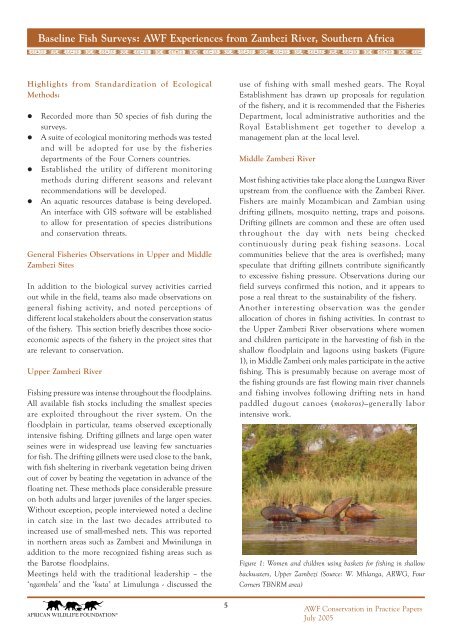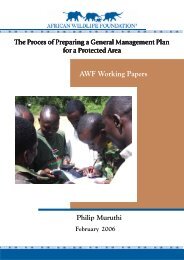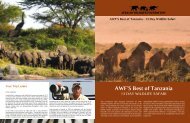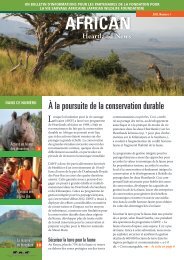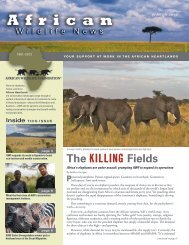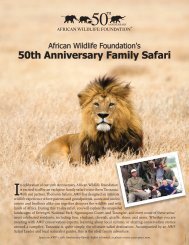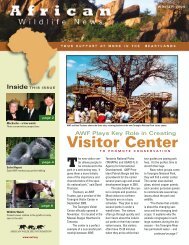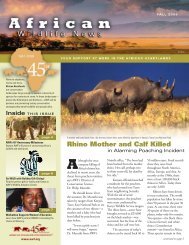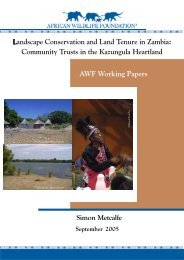Baseline Fish Biodiversity Surveys - African Wildlife Foundation
Baseline Fish Biodiversity Surveys - African Wildlife Foundation
Baseline Fish Biodiversity Surveys - African Wildlife Foundation
- No tags were found...
You also want an ePaper? Increase the reach of your titles
YUMPU automatically turns print PDFs into web optimized ePapers that Google loves.
<strong>Baseline</strong> <strong>Fish</strong> <strong>Surveys</strong>: AWF Experiences from Zambezi River, Southern AfricaHighlights from Standardization of EcologicalMethods:• Recorded more than 50 species of fish during thesurveys.• A suite of ecological monitoring methods was testedand will be adopted for use by the fisheriesdepartments of the Four Corners countries.• Established the utility of different monitoringmethods during different seasons and relevantrecommendations will be developed.• An aquatic resources database is being developed.An interface with GIS software will be establishedto allow for presentation of species distributionsand conservation threats.General <strong>Fish</strong>eries Observations in Upper and MiddleZambezi SitesIn addition to the biological survey activities carriedout while in the field, teams also made observations ongeneral fishing activity, and noted perceptions ofdifferent local stakeholders about the conservation statusof the fishery. This section briefly describes those socioeconomicaspects of the fishery in the project sites thatare relevant to conservation.Upper Zambezi River<strong>Fish</strong>ing pressure was intense throughout the floodplains.All available fish stocks including the smallest speciesare exploited throughout the river system. On thefloodplain in particular, teams observed exceptionallyintensive fishing. Drifting gillnets and large open waterseines were in widespread use leaving few sanctuariesfor fish. The drifting gillnets were used close to the bank,with fish sheltering in riverbank vegetation being drivenout of cover by beating the vegetation in advance of thefloating net. These methods place considerable pressureon both adults and larger juveniles of the larger species.Without exception, people interviewed noted a declinein catch size in the last two decades attributed toincreased use of small-meshed nets. This was reportedin northern areas such as Zambezi and Mwinilunga inaddition to the more recognized fishing areas such asthe Barotse floodplains.Meetings held with the traditional leadership – the‘ngambela’ and the ‘kuta’ at Limulunga - discussed theuse of fishing with small meshed gears. The RoyalEstablishment has drawn up proposals for regulationof the fishery, and it is recommended that the <strong>Fish</strong>eriesDepartment, local administrative authorities and theRoyal Establishment get together to develop amanagement plan at the local level.Middle Zambezi RiverMost fishing activities take place along the Luangwa Riverupstream from the confluence with the Zambezi River.<strong>Fish</strong>ers are mainly Mozambican and Zambian usingdrifting gillnets, mosquito netting, traps and poisons.Drifting gillnets are common and these are often usedthroughout the day with nets being checkedcontinuously during peak fishing seasons. Localcommunities believe that the area is overfished; manyspeculate that drifting gillnets contribute significantlyto excessive fishing pressure. Observations during ourfield surveys confirmed this notion, and it appears topose a real threat to the sustainability of the fishery.Another interesting observation was the genderallocation of chores in fishing activities. In contrast tothe Upper Zambezi River observations where womenand children participate in the harvesting of fish in theshallow floodplain and lagoons using baskets (Figure1), in Middle Zambezi only males participate in the activefishing. This is presumably because on average most ofthe fishing grounds are fast flowing main river channelsand fishing involves following drifting nets in handpaddled dugout canoes (mokoros)—generally laborintensive work.Figure 1: Women and children using baskets for fishing in shallowbackwaters, Upper Zambezi (Source: W. Mhlanga, ARWG, FourCorners TBNRM area)5AWF Conservation in Practice PapersJuly 2005


